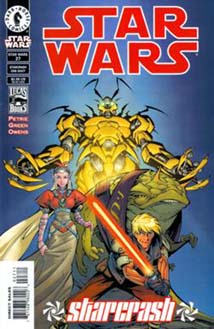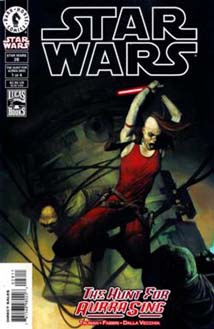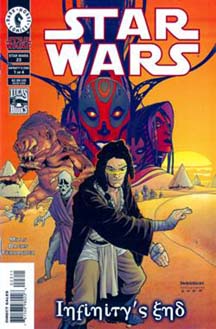When we last checked in with the heroes and villains of “Star Wars: Republic,” the title had built up serious narrative momentum: Quinlan Vos and Aayla Secura had become central characters, but not only did we not know their backstories, but – thanks to the memory-loss effects of glitteryl spice, neither did they. Meanwhile, Force-using and Jedi-loathing bounty hunter Aurra Sing was still out there.
Since “Infinity’s End” (Issues 23-26, from 2000-01) and “The Hunt for Aurra Sing” (28-31, 2001) featured Quinlan and Aurra, respectively, it seemed we’d get some answers. However, somewhat unfortunately, these are both action-oriented titles that keep the big reveals on the back burner. There a plenty of reasons to recommend them, but a reader might’ve expected more in the characterization department.
“Infinity’s End” – Quinlan Vos’ first mission in his rehab assignment with the Jedi Order, but not one where he learns anything about his past — is notable for introducing two major elements that would be revisited in later “Star Wars” works, although one might assume that Dark Horse itself didn’t respect this arc as it chose not to give it the trade-paperback treatment (it would eventually get an omnibus release). This is the only “Star Wars” work by writer Pat Mills, but he introduces Infinity Gates (essentially, the space-travel portals from “Stargate”), which would later be revisited in the “Dawn of the Jedi” comics and novel as precursors to shipboard hyperspace travel.
Also, artists Ramon F. Bachs (pencils), Raul Fernandez (inks) and Dave McCaig (colors) give us the first visual depiction of the Witches of Dathomir, who became fan favorites from the otherwise not-so-great Dave Wolverton novel “The Courtship of Princess Leia.” While “The Clone Wars” added the notion of the Nightbrothers on the other side of the planet, showing that at least certain clans of Nightsisters weren’t totally sexist toward men, “Infinity’s End” finds this particular clan treating all “malelings” as slaves and breeding stock. However, “The Clone Wars” did use the Bachs/Fernandez portrayal almost verbatim, as the comics’ Queen Zalem looks quite similar to the TV show’s Mother Talzin.
In the latest example of an intriguing “Star Wars” arc that goes nowhere, Quinlan brings his attempted murderer, the Nightsister Ros Lai, back to the Jedi Temple. Lai stands in the council’s circle with him, guarded but not restrained. “Somewhere within her, I sense the light side of the Force,” Quinlan explains. But a quick check of Wookieepedia reveals Ros Lai is never heard from again except to pop up in a “Clone Wars” video game.

I was excited to re-read the one-shot “Starcrash” (Issue 27, February 2001), seeing that it was written by “Buffy” veteran Doug Petrie, but there’s a reason why I didn’t remember it. A Padawan whom we’ll never hear from again crashes on a planetoid we’ll never visit again and falls for a princess we’ll never see again. Taken alone, it’s a fun little tale that’s reminiscent of those “random royal planet” standalones from the Marvel “Star Wars” run, except without a main character. But in the midst of juicy Quinlan Vos and Aurra Sing arcs, it’s a bit annoying.


Tim Truman’s “The Hunt for Aurra Sing” picks up with Aurra killing two Jedi on Coruscant for a bounty, showing us that – as with her introductory arc in Truman’s “Outlander” – she has a pretty sweet deal going where she can do what she loves and get paid for it. Plus, some of Aurra’s inner-monologue boxes are back, and it seems everything is pointing toward the much-anticipated Aurra vs. Dark Woman showdown. (As we learned in “Aurra’s Song,” Aurra believes her former teacher sold her into Hutt slavery. We haven’t learned the Dark Woman’s view on this specific accusation, but we do know she blames herself for failing as a teacher and unleashing a “dangerous beast” upon the galaxy.)
With the vibrant artwork of one of my favorite “Star Wars” teams – Davide Fabbri (pencils), Christian Dalla Vecchia (inks) and McCaig (colors) – I can’t exactly say “The Hunt for Aurra Sing” should be skipped. It’s an action-packed chase yarn that’s gorgeous to look at. However, the payoff punch doesn’t land as A’Sharad Hett’s story steals the spotlight: He nearly kills Aurra in a lightsaber fight and fears he has been tempted by the dark side – and Aurra and the Dark Woman miss confronting each other.
The good news is that there’s no doubt Truman is setting up more pins for another roll and I feel confident that these plot elements won’t go the way of Ros Lai. The Dark Woman offers to take over A’Sharad’s training from Ki-Adi-Mundi. “I need this boy, Ki. And he needs me,” she says. This should add a juicy element to the whole Aurra Sing plotline since Aurra killed A’Sharad’s father. And since the Dark Woman has been known to push the boundaries of the light side, and we know she’s obsessed with removing Aurra as a galactic threat, it’s possible that she might be tempted to turn her new Padawan into a killing weapon with his sights set on her former Padawan.

